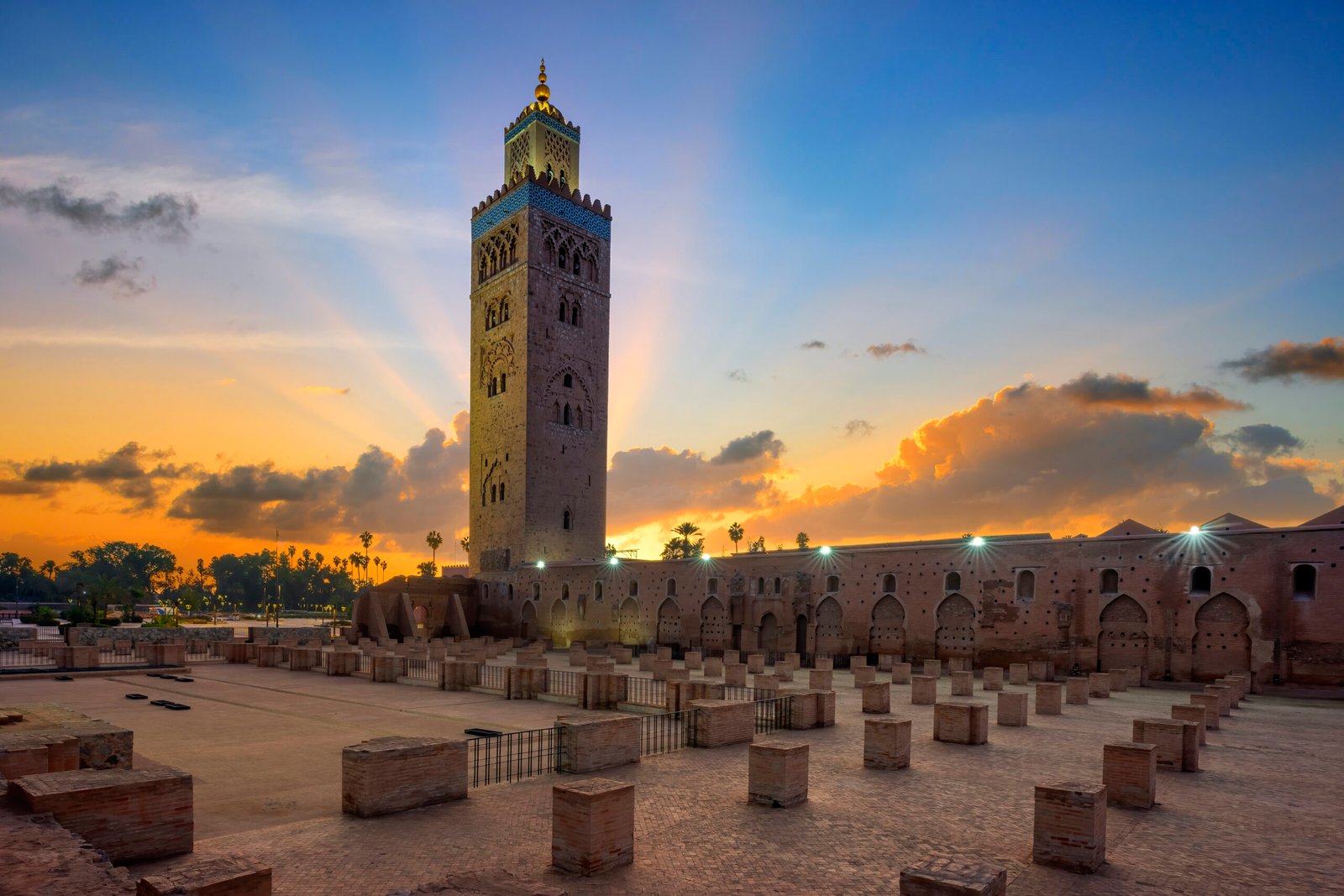A Cultural Tour of Morocco’s Imperial Cities
If Morocco is a mosaic of culture, Marrakech is the bold red tile in the center. Known as the “Red City” thanks to its rose-hued walls and buildings, Marrakech is loud, alive, and completely unapologetic.
Talking about Morocco’s Imperial Cities, start your visit in Jemaa el-Fnaa, the main square that feels like a medieval circus. You’ll find snake charmers (yes, real ones), henna artists, street performers, and food vendors selling everything from lamb skewers to snail soup.
Head into the medina (old town) for an unforgettable maze of souks selling lanterns, leather, spices, rugs, and just about anything you didn’t know you wanted. Haggling is part of the fun—don’t be shy, just be respectful.
Cultural Highlights:
- Bahia Palace – Ornate architecture and tranquil courtyards.
- Koutoubia Mosque – Marrakech’s landmark minaret, visible from nearly everywhere.
- Majorelle Garden – A dreamy blend of art and botany (Yves Saint Laurent helped restore it).
Candid tip: Marrakech is intense. Take breaks—preferably in a riad rooftop with mint tea and city views.
Fez: The Spiritual and Intellectual Soul of Morocco
Talking about Morocco’s Imperial Cities, Fez doesn’t try to charm you. It’s raw, complex, and proud of its heritage. But give it time, and it just might become your favorite.
The medina of Fez el-Bali is a UNESCO World Heritage site and one of the largest car-free urban areas in the world. Getting lost is inevitable—and that’s half the experience. Here, craftsmen still tan leather in ancient pits, and donkeys share alleyways with shoppers and scholars.
Don’t Miss:
- Chouara Tannery – Yes, it smells. Yes, it’s fascinating. Watching leather being dyed the traditional way is worth the olfactory sacrifice.
- Al Quaraouiyine University – Arguably the oldest university in the world, founded in 859.
- Medersa Bou Inania – A stunning theological college with some of the most beautiful tilework you’ll see in Morocco.
Candid tip: Hire a local guide. Fez is a labyrinth, and without a guide, you'll probably miss its deeper stories.
Meknes: The Quiet Imperial City
Talking about Morocco’s Imperial Cities, often overshadowed by its more famous neighbors, Meknes is Morocco’s most underrated imperial city—and that’s exactly why you should go.
Laid-back and less chaotic, Meknes has an authenticity that feels unfiltered. Once the capital under Sultan Moulay Ismail, the city is known for its massive gates, palaces, and impressive granaries.
Top Sites:
- Bab Mansour – One of Morocco’s most beautiful gates.
- Royal Stables & Granaries – Once built to house 12,000 horses (seriously).
- Moulay Ismail Mausoleum – A sacred site and architectural gem.
Candid tip: You only need a day or two in Meknes, but it’s a peaceful break from the tourist crowds of Marrakech and Fez.
Rabat: The Calm Capital
Talking about Morocco’s Imperial Cities, Rabat, Morocco’s current capital, often gets skipped over by travelers—and honestly, that’s a mistake. While it may lack the chaotic energy of Marrakech or Fez, it makes up for it with elegant boulevards, coastal views, and a calm vibe that’s perfect for travelers who want to experience Morocco at a more relaxed pace.
It’s also a great introduction to Moroccan urban life—less intense, more navigable, but still full of cultural richness.
Highlights Include:
- Kasbah of the Udayas – A peaceful, blue-and-white neighborhood overlooking the ocean.
- Hassan Tower and Mausoleum of Mohammed V – A site that beautifully blends ancient and modern history.
- Chellah Necropolis – Roman ruins mixed with medieval Islamic architecture and wild storks.
Candid tip: If you're flying into or out of Rabat, spend at least one night here—you’ll be surprised by how much you enjoy the calm.
A Few Tips for Your Imperial Adventure
- Talking about Morocco’s Imperial Cities, dress modestly, especially in medinas. Morocco is modern, but conservative values still shape daily life.
- Learn a few words of French or Arabic. Even “bonjour” or “shukran” (thank you) goes a long way.
- Stay in riads. These traditional guesthouses often have inner courtyards and serve delicious breakfasts. Plus, they’re far more atmospheric than a hotel.
- Take it slow. These cities weren’t built for speed. Slow down, sip some mint tea, and let the culture soak in.
Final Thoughts
A cultural tour of Morocco’s Imperial Cities isn’t just about monuments and museums. It’s about wandering through centuries-old medinas, hearing the call to prayer echo through ancient alleyways, and sharing tea with locals who are proud to show off their heritage.
It’s chaotic. It’s beautiful. It’s sometimes frustrating. But above all—it’s real.
And that’s what makes Morocco unforgettable.
For more information, visit
our website now.
